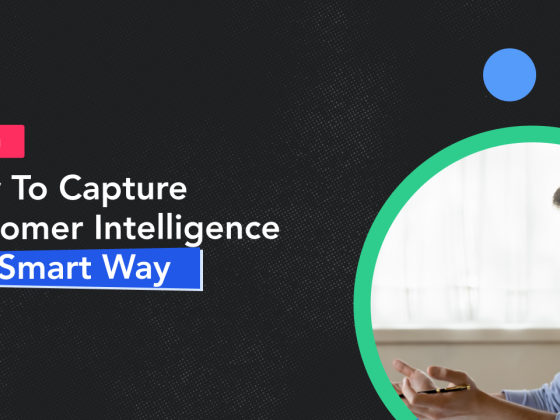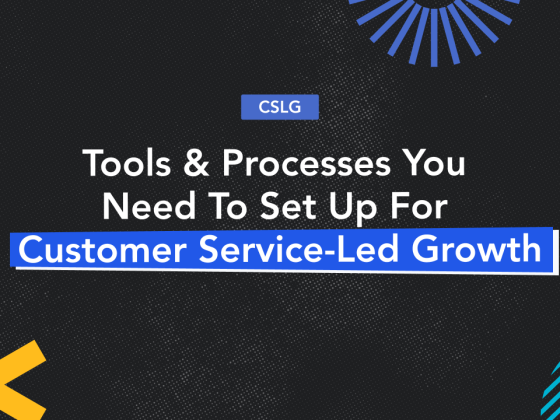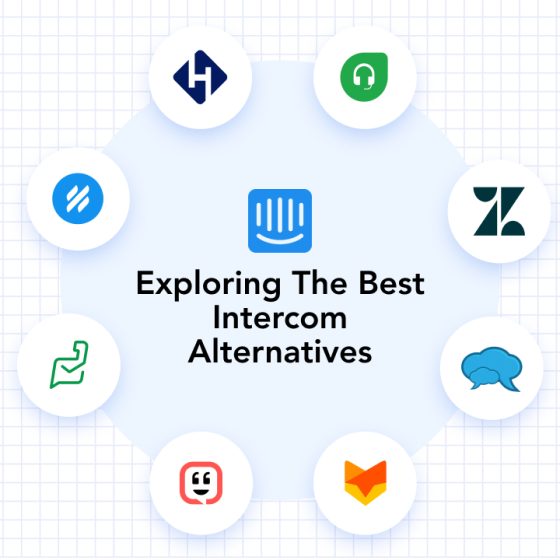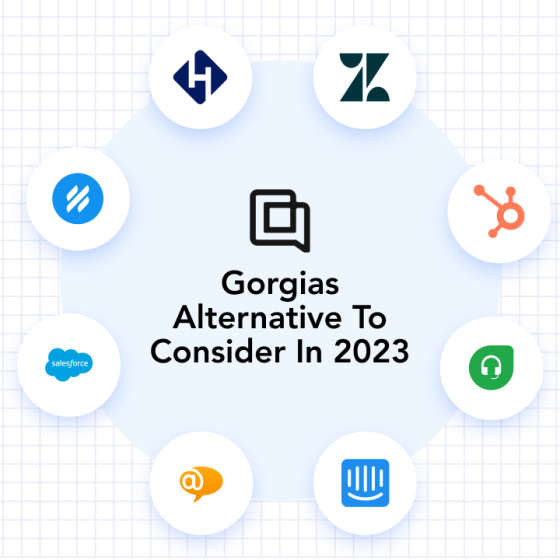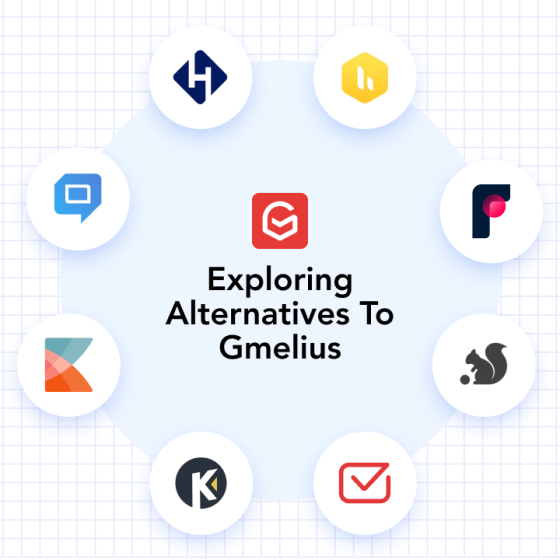It is Saturday night, and you and your parents, decide to watch a movie/series on Netflix. You switch on the smart TV, log into your Netflix account, and browse for random suggestions.
While doing so, the OTT platform flashes a scary section that reads, “Because you watched Fifty Shades of Grey,” and provides suggestions based on your watch history.
And the rest, as they say, is history…
Wondering how Netflix curates personalized recommendations for its viewers? Say thanks to artificial intelligence (AI) and machine learning (ML).
Customer service for small businesses has evolved from “nice-to-have” to “must-have.” It is a powerful determinant of customer loyalty and purchasing decisions. Moreover, the customer service realm is changing and will only continue to do so. Managing and understanding customers’ emotions and expectations has always been the biggest undertaking – until now.
With AI for customer service, communicating with people has transformed for the better. Best-in-breed customer service companies are increasingly leveraging AI as a unique selling point (USP), especially amid economic uncertainty and price hikes.
Indeed, AI deployment has ballooned by almost 2.5X since 2017. However, the fraction of businesses using the technology has stood between 50-60% over the past few years.
But why is the remaining proportion still hesitant to leap onto the AI bandwagon?
This article guides you through the ins and outs of both AI and non-AI customer service software.
Pros of Customer Service Tools with AI Capabilities
Businesses deploying AI customer service software enjoy the following benefits:
01. Super-fast Responses
Are you looking to reduce the time your agents spend on each customer-facing conversation? AI-driven chatbots are incredibly helpful here.
These intelligent applications answer routine customer queries in a jiffy without human assistance. At the same time, complex inquiries are transferred to appropriate agents’ inboxes from where they can take over the conversations.
As such, people do not have to wait long to get their requests addressed – they can just ask the chatbot for help.
Besides, you can set up automated responses with AI software for customer service – meaning replies on the fly. Chatbots utilize AI algorithms to provide support agents with ready-to-send answers they can feed into chat boxes. This eliminates the need for teams to find responses themselves.
Furthermore, chatbots are immune to time constraints and holiday-offs. These AI tools for customer service are available to serve customers round the clock.
02. Infuse Hyper-personalization into Customer Experiences
One of customer service’s biggest challenges is striving to meet increasingly high standards of customer satisfaction (CSAT). In fact, 7 out of 10 customers expect brands to understand unique wants and needs.
Even when you are doing fine (or you think so), it is never enough.
The solution? Hyper-personalization. While human agents have been somewhat tailoring customer-facing interactions, AI customer service software helps them do the job better.
By combining the power of artificial intelligence, big data, and machine learning, you can understand people’s intent and needs better than ever seen, based on their feedback on previous conversations.
Does any client want to receive support with the voice of Homer Simpson? AI tools for customer service can manage it in minutes.
03. Better Understand Customers’ Sentiments
As people’s interaction with businesses grows, so does the amount of data created. Every day, businesses and consumers alike generate 328.77 million terabytes of data –about 120 zettabytes a year.
Ever thought why Flipkart knows what you would like based on your recent purchases, frequent page visits, and social media sharing? Or how Spotify examines your listening habits and music preferences to give you song recommendations?
That is machine learning algorithms in action.
Call center AI software leverages natural language understanding (NLU) to put customer service emails, calls, and chats under a microscope in real-time.
Case in point, sentiment analysis processes several customer-facing interactions. It highlights recurring words or phrases, indicating an ongoing problem with a particular aspect of your customer service.
These insights help your agents understand and predict customers’ emotions and formulate the next best action to level up customer service in advance.
04. Keep Up with Changing Customer Needs
The real potential of AI customer support comes from their capability to learn and embrace new situations. Typically, the more data AI collects about your business and industry, the faster and easier it will match its recommendations and suggestions to your brand’s goals.
What is more, these insights can offer you a considerable advantage over your rivals. That said, it is not only about outsmarting your peers in customer service.
AI software for customer service enables you to monitor current as well as future market trends efficiently. The technology identifies and categorizes customers based on their behavior and psychological profiles during previous conversations.
You can then leverage the information to adjust your customer service operations to make a better impression on prospects and existing customers.
Cons of Customer Service Tools with AI Capabilities
Here are some possible risks of customer service software for small businesses:
01. High Upfront Costs
A solid, high-performance AI customer support system equates to more technology and complicated frameworks. With complexities come expenses.
Deploying and training AI chatbots add significant initial costs for customer service organizations. Their upkeep further puts a hole in your pocket as these systems require close monitoring to prevent breakdowns and intrusions.
Not only that, you need to hire skilled employees to manage customer service software properly. Building and educating chatbots needs accurate data management, which requires specialized staff.
In some situations, this capital escalates if you rope in third parties to manage the systems. However, Helpwise truly understands the concern. Its customer service platform is studded with leading-edge AI capabilities that are user-friendly, low-upkeep, and do not hurt your bank balance.
02. Integrating AI Tools with Existing Systems
Switching to AI for customer service goes beyond downloading a few plugins to your existing infrastructure. You have to take some (or maybe a lot) to figure out whether you have the processors, data storage, and infrastructure essential for the system to function optimally.
Plus, you need to check the compatibility of the current framework with AI tools for customer service. Apart from these, you must educate your agents about working with the innovative system during and after the transition. That includes using multiple features, troubleshooting simple issues, and identifying where AI algorithms fall flat.
03. Lack of Human Touch
Emotions, such as sympathy, empathy, and anger, make us human. No doubt, AI is trained to be more “human-like,” but it will never match the human persona.
While AI customer service software efficiently resolves basic people’s issues/queries, it folds when it comes to understanding the entire scope of conversations. This is because chatbots run on codes and thus only recognize phrases or keywords, not the emotional nuances of customers’ remarks.
04. Security and Privacy Woes
Research suggests that 9 out of 10 enterprise networks are prone to (external) cyberattacks.
One of the potential challenges with AI for customer service is the program is vulnerable to threats unless properly secured.
A sudden security breach in the system can result in the leakage of tons of confidential customer data. According to a report, a data breach costs businesses worldwide US$4.35 Mn on average.
Not only would such cybercrimes put customers’ privacy at stake, but they would also put businesses’ reputation on the firing line in case of legal disputes.
So, whatever customer service software you utilize, ensure that the application covers all privacy and security gaps for you, your agents, and your customers.
Pros of Customer Service Tools without AI Capabilities
Businesses sticking with customer service tools without AI capabilities experience these benefits:
01. Straightforward Setup
Non-AI customer service tools are easily available compared to their AI variants. Moreover, the deployment is straightforward – all you need is smooth Wi-Fi, Internet-enabled devices (smartphones, laptops, and tablets), headsets, and basic spreadsheet software – and you are good to go.
Furthermore, you have the entire ownership of the system. So, if your customer service business has just taken off, getting started with conventional tools can be a wise decision.
02. Easier to set up
Unless your agents belong to the “Generation Z” brigade, they must be well aware of conventional customer service tools. As such, you need not invest time and money in coaching your staff about operating a new setup – no steep learning curve.
In some cases, installation is not needed as previous agents might have left the equipment ready to go.
03. Greater Control Over Conversations
Legacy customer service tools without AI capabilities mean all customer-facing conversations are “human-only.” Since agents have to manage a single channel, they clearly understand their responsibilities and goals.
While AI chatbots also solve routine customer requests, you need human agents to address complex queries. That is because they understand customers’ emotions and intent better than code-driven machines, which can only decipher blocks of text.
Hence, your agents can take responsibility for all communications, offering them greater control over every conversation with clients.
04. Reduced Data Privacy and Security Concerns
With non-AI customer service tools, you do not have to worry about data privacy and security. Since data packets flow via the Internet, all you need is a basic anti-virus or anti-theft package to protect the network.
You do not need to dedicate your resources to deploying compute-heavy cybersecurity solutions or creating policies to safeguard online data. This saves you tons of effort, time, and, of course, money.
Remember, the fewer your customer-facing interactions happen online, the more you are immune to the wrath of threat actors.
Cons of Customer Service Tools without AI Capabilities
On the flip side, the obsession with non-AI customer service software can land you at these downsides:
01. Increased Agent Workload and Burnout
As your business grows, so does the query inflow. Your support agents will find it challenging to keep pace with increased workloads with non-AI customer service tools. You will often receive several customers’ requests, issues, and queries to address, and your agents will remain under-equipped to attend to them in real-time.
Inadequate work prioritization results in burnout, mismanagement, and lower agent productivity.
02. Case Resolutions Take Long
Inbound emails, query status, and activity log, all form part of the same thread – everything is topsy-turvy. Non-AI customer service software lacks the suitable tools to monitor query inflows across multiple channels.
For instance, a customer can raise a query via email and follow up on the phone.
However, agents cannot retrieve service request history with non-AI customer service software. Plus, you could find more than one of your agents working on the same issue – agent collision – due to duplicate responses. Worse, each of those agents provides different solutions to the customer.
This is the ideal recipe for chaos. Such comedy of errors increases query resolution times, leaving customers frustrated.
03. Inefficient Data Handling
AI customer service software holds the potential to process large data chunks and extract actionable insights from customer-facing conversations. However, without AI, monitoring key performance indicators (KPI), including CSAT score, average handling time (AHT), and net promoter score (NPS), seems a next-to-impossible task.
The amount of data generated will only surge in the coming years – likely to clock 180 zettabytes in 2025, 60 units up from the 2023 figures. So, using non-AI customer service tools means letting critical information slip below your nose.
04. Unable to Catch up With Business Needs
AI software for customer service processes enormous volumes of data generated to anticipate trends and key areas of interest. For instance, by assessing previous interactions with customers and ongoing industry trends, you can tailor conversations accordingly to strike the right chord in customers’ minds.
Unfortunately, in non-AI-driven customer service software, analytics and reporting consumes significant time per se, leaving agents less time for core operations.
Factors to Consider When Choosing Customer Service Tools
When weighing up customer service software for small businesses, here are some vital things to focus on:
01. Business Requirements
Your corporate needs will decide what sort of customer service tools and features you require. That said, any software you choose will only play second fiddle, with your support agents donning the leading role. As such, bring them together for boardroom meetings to discuss the business requirements, which generally stem from existing challenges:
- Poor customer communication
- Long response times
- Inability to gather relevant insights
- Difficulty in managing agent schedules
- Insufficient visibility into agents’ performance
Tie together all of your issues to identify your business requirements. With that checklist, you can now talk shop.
02. Budget
The price tag is a vital consideration for startups and small-scale establishments. Therefore, many initially settle with free customer service tools to kick-start their business and later on upgrade to paid subscriptions when they scale up.
However, a higher price tag does not always mean more features in AI customer support software. So, explore multiple options, compare features, and read online reviews before making a purchase. Look no further than Helpwise if you want to use numerous features without crossing your budget.
03. Compatibility with Existing Systems
The best AI tools for customer service must go along well with the tools you already use at your business. So, check how compatible the new software will be with current business operations and apps.
For instance, if you use a project management , financial management, or e-commerce solution, check whether the new addition will complement or hinder their capabilities.
Remember this advice while purchasing the right AI customer service software.
04. Security & Compliance
Often neglected, a critical factor when considering any AI customer service solution is whether it can shield confidential data from cyberattacks. Case in point, pay attention to compliance with local norms if you serve customers from multiple countries.
Consider everything from basic security tools and access controls to compliance certifications, including GDPR, HIPAA, and CAMS. Plus, determine how scattered the service provider’s data centers are across continents.
AI Emerges as the Clear Winner
Next-gen AI software for customer service is not only arriving; it is revolutionizing the business landscape in unimaginable ways a few years ago. Brands can automate manual operations, assess customer feedback and sentiment with pinpoint accuracy, and offer top-notch customer service at a fraction of yesterday’s cost.
Of course, AI customer support systems demand higher initial investments versus their non-AI counterparts. Nevertheless, their total cost of ownership (TCO) is considerably low down the road.
So, if you want to play the long game, investing in AI tools for customer service is a no-brainer.
Take a 14-day free test drive of Helpwise’s customer service software to optimize your support processes.
Got interested? Check out our next article, “The Ultimate Guide to Choosing the Right AI-Powered Customer Service Tool,” for more.
FAQs
What are the pros and cons of AI-enabled customer service software?
Advantages include:
- At-scale personalized customer-facing conversations
- Faster responses to customers’ queries
- Deeper insights into communications
- Near accurate prediction of market trends and customer behaviors
Disadvantages include:
- Concerns regarding data privacy and security
- High initial costs
- Inadequate human-like interactions
- Lots of time and money spent during the transition to the new setup
What are the pros and cons of non-AI customer service software?
Advantages include:
- Low upfront expenses
- Easy to install and use
- Lesser anxiety regarding data security and privacy
- Closer watch on customer-facing conversations
Disadvantages include:
- Longer response times
- Cannot keep up with evolving market trends and customers’ sentiments
- Increased agent fatigue and burnout
- Raw data analysis
What factors should companies consider while looking for the best AI customer support platform?
Businesses should keep these things in mind while browsing for the right AI software for customer service:
- Unique business needs
- Budget limitations
- Security and compliance frameworks
- Compatibility with current tools

